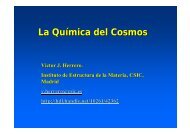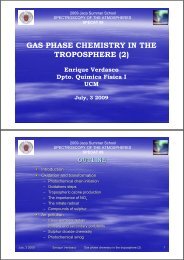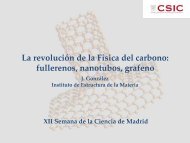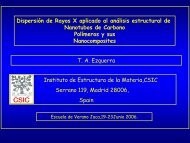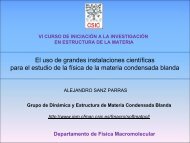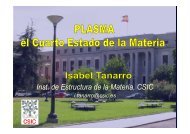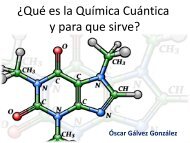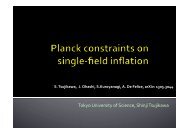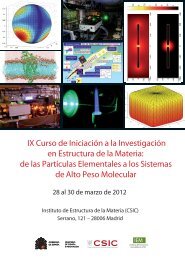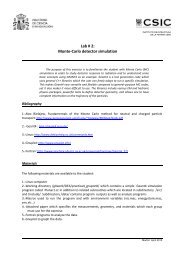Liquid hydrogen fi<strong>la</strong>ment (5 micron in diameter) at 15 K temperature, crossed by the exciting <strong>la</strong>ser at 100 micronoff the nozzleLASER SPECTROSCOPYThe bulk of the work carried out during <strong>2011</strong> in the Laser Spectroscopy line has been done using the Stimu<strong>la</strong>tedRaman Spectroscopy Technique in different configurations, studying several molecu<strong>la</strong>r species relevant in differentfields. The first one of those is 13 C 12 CD 2 , an isotopologue of acetylene that has been studied within the frameworkof an already well established col<strong>la</strong>boration with the University of Bologna. The main goal of this col<strong>la</strong>boration isthe precise mo<strong>de</strong>lling of ro-vibrational energy levels in the whole family of “common” isotopologues (mono- ordoubly- substituted with 13 C and D) of acetylene. In <strong>2011</strong> we have obtained room temperature stimu<strong>la</strong>ted Ramanspectra of the 1 , 2 , 2 + 4 - 4 , 2 + 5 - 5 , 2 +2 4 -2 4 , 2 +2 5 -2 5 , 2 + 4 + 5 - 4 -bands of this molecule. Moreover,using the Raman-Raman double resonance technique we have also recor<strong>de</strong>d the Raman spectrum of the 2 2 - 2 hotband at 160 K in non-rotational equilibrium at different pressures. Besi<strong>de</strong>s the information about the energy levelsof this molecule, the analysis of these spectra has revealed a J=2 propensity rule for the rotational re<strong>la</strong>xation of thismolecule. This propensity rule has been already observed for diatomic molecules, but it had not been observedbefore in a polyatomic, making this observation relevant enough as to be published as rapid communication in theJCP. The analysis of the rest of the bands has also been successfully finished and the results have been publishedseparately.The next studied species has been 12 CF 4 , a molecule that raises interest in atmospheric studies due to its <strong>la</strong>rge globalwarming potential (GWP) some 6000 times bigger than that of CO 2 , and its 50000 year lifetime in the atmosphere.We have obtained high resolution Raman spectra at room temperature of the 1 , 2 1 - 1 , 2 , 2 2 , 1 + 4 - 4 and 3 2 - 2bands, and 150 K spectra of 2 1 - 1 and the exten<strong>de</strong>d 2 band. The analysis of all these spectra is being done at theUniversity of Burgundy by our colleague V. Boudon.We have also conclu<strong>de</strong>d and published a study of the 13 C-substituted ethane ( 12 CH 3 - 13 CH 3 ) whose analysis has beendone in col<strong>la</strong>boration with Prof. N. Moazzen Ahmahdi of Calgary University, and another study on the N 2 moleculefor which we have measured with high precision the broa<strong>de</strong>ning by self-collisions at different temperatures.In the Difference Frequency Infrared <strong>la</strong>boratory, we have <strong>de</strong>veloped a method of precise wavenumber measurementusing a transfer cavity and an I 2 locked Ar + <strong>la</strong>ser as absolute reference. The termination of this system is pending ofthe procurement of a commercial wavemeter with an accuracy of 10 MHz. We have completed a preliminaryassessment of the performance of the system, yielding a S/N better than 1:2000. The accuracy of the wavenumberscale in this preliminary stage is ~2x10 -4 cm -1 , taking as reference the most accurate avai<strong>la</strong>ble frequencies for theP(7) multiplet of the 3 band of CH 4 measured with an optical frequency comb.Also in this <strong>la</strong>boratory we have started the set-up of an experiment aimed towards the acquisition of high resolutionstimu<strong>la</strong>ted Raman spectra with cw-<strong>la</strong>sers insi<strong>de</strong> a new type of optical fibers: hollow core photonic crystal fibers(HCPCF). The guiding mechanism in these fibers (the photonic band-gap effect) makes it possible to <strong>de</strong>sign a low-70
loss hollow core fiber, amenable to be filled with a gas sample. The high <strong>de</strong>gree of light confinement together witha longer interaction length has led to the conception of a new experimental configuration to carry out high resolutionRaman spectroscopy without pulsed <strong>la</strong>sers.Finally, we have observed the first Raman signals with an spectralresolution better than 0.006 cm -1 and a remarkable signal to noise ratio in the ν 1 band of CO 2 at 100 kPa.THEORETICAL MOLECULAR PHYSICSMolecu<strong>la</strong>r Quantum Control. Molecu<strong>la</strong>r alignment and orientationWe have studied the control of alignment and orientation of po<strong>la</strong>r molecules in optical <strong>la</strong>ttices, using a combinationof static electric field and a pulse train of non-resonant <strong>la</strong>ser pulses. Long-range dipo<strong>la</strong>r interaction strongly affectsthe macroscopic properties of a quantum gas and this field is very active. The control of the orientation of molecu<strong>la</strong>rdipoles provi<strong>de</strong>s a handle to control these macroscopic properties.A very important application of this system is quantum computing. We have found that the inclusion of nonresonant<strong>la</strong>ser pulses allows controlling the entanglement of dipo<strong>la</strong>r molecules in an optical <strong>la</strong>ttice.For iso<strong>la</strong>ted molecules, we have carried on the study of cyclic states for potentials HCP (Half-Cycle Pulse). Thoseintrinsically asymmetric potentials allow for the direct orientation of dipo<strong>la</strong>r molecules and the cyclic states can becreated and controlled adiabatically un<strong>de</strong>r appropriate evolution of the control field.Control of the torsional angles of nonrigid molecules is key for the <strong>de</strong>velopment of emerging areas like molecu<strong>la</strong>relectronics and nanotechnology. Based on a rigorous calcu<strong>la</strong>tion of the rotation-torsion-Stark energy levels ofnonrigid biphenyl-like molecules, we have shown that, unlike previously believed, instantaneous rotation-torsion-Stark eigenstates of such molecules, interacting with a strong <strong>la</strong>ser field, present a <strong>la</strong>rge <strong>de</strong>gree of <strong>de</strong>localization inthe torsional coordinate even for the lowest energy states. Thus, we have shown that adiabatic control of changes onthe p<strong>la</strong>narity of this kind of molecule is essentially impossible unless the temperature is on the or<strong>de</strong>r of a few Kelvin.We have also continued the study of energy transfer in light-harvesting complexes (LHC) and the importance ofquantum coherence and the back-action of the molecu<strong>la</strong>r environment on the energy flow. We have used an excitonmo<strong>de</strong>l for the energy transfer and calcu<strong>la</strong>ted the energy-transfer efficiency and the trapping time for the Fenna-Matthews-Olson complex. We have used the mo<strong>de</strong>l to interpret two-dimensional echo-spectra of this complex. Thiswork has been done in col<strong>la</strong>boration with the group of Tobias Kramer from the University of Regensburg.Ultracold Quantum gasesWe have studied the momentum generation in a system of atoms at rest in an optical <strong>la</strong>ttice, modu<strong>la</strong>ting the<strong>la</strong>tticewith an unbiased time and spatially periodic <strong>la</strong>ser field. . Generation of an asymptotic current at infinite timeis only possible when both time and spatial symmetry of the system are broken. Our work shows that by using atailored potential that does not break time-reversal symmetry it is still possible to maintain a relevant net averagecurrent in a time scale that can be fitted to the lifetime of actual experiments. Our mo<strong>de</strong>l has proven to be bothhighly control<strong>la</strong>ble and robust. We have studied the effect of particle interaction on this mo<strong>de</strong>l, and found that apulsed modu<strong>la</strong>tion of the interaction parameter can create and control a persistent current.We have carried on the study of the use of atom counting as a tool to distinguish strongly corre<strong>la</strong>ted phasesofultracold atoms, both for bosons and fermions, in col<strong>la</strong>boration with the group of Prof. M. Lewenstein from<strong>Instituto</strong> <strong>de</strong> Ciencias Fotónicas.2B.4 MACROMOLECULAR PHYSICS DEPARTMENTRESEARCH LINES:‣ Simu<strong>la</strong>tion of polymer reactions and of physical properties of polymers.‣ Physical properties and nanostructure of polymers.‣ Polymer Physics: Or<strong>de</strong>r and mobility in macromolecu<strong>la</strong>r systems.‣ Application of the synchrotron light to the study of polymers and nanostructured materials.‣ Interfaces.RESEARCH SUBLINES:71
- Page 3:
INTRODUCCIÓNEl Instituto de Estruc
- Page 10 and 11:
Dra. Maria Esperanza Cagiao Escohot
- Page 12 and 13:
TALLER ÓPTICOD. José Lasvignes Pa
- Page 14 and 15:
2A.1 DPTO. DEQUÍMICA YFÍSICA TEÓ
- Page 16:
empezar a caer. Este fenómeno se e
- Page 19 and 20: Existen varias diferencias entre la
- Page 21 and 22: Estudio de las propiedades estructu
- Page 23 and 24: poblar los estados de interés en 1
- Page 25 and 26: Si bien la técnica TF está bien e
- Page 27 and 28: que no se produzca la ruptura de en
- Page 30 and 31: antitumoral emodina mediante el efe
- Page 32 and 33: Esta formulación ha sido desarroll
- Page 34 and 35: oooooCriogenia.Espectroscopía Rama
- Page 36 and 37: FLUIDODINÁMICA MOLECULAREl princip
- Page 38 and 39: También se ha concluido y publicad
- Page 40 and 41: o Análisis mecánico en tracción:
- Page 42 and 43: cuerpo (BCC), tiene lugar la formac
- Page 44 and 45: BIOSAXSCaracterización de coloides
- Page 46 and 47: Sin embargo, desde el punto de vist
- Page 48 and 49: 2B.1 THEORETICAL PHYSICS AND CHEMIS
- Page 50 and 51: terms and that b) stellar pulsation
- Page 52 and 53: We have investigated transport thro
- Page 54 and 55: een proposed as possible interstell
- Page 56 and 57: The figure shows a compilation of t
- Page 58 and 59: oppositely aligned spins. This pair
- Page 60 and 61: PHYSICAL BEHAVIOR AT NANO-SCALESPro
- Page 62 and 63: done in collaboration with research
- Page 64 and 65: Finally, we have also conducted a w
- Page 66 and 67: species have been obtained from tim
- Page 68 and 69: Rideal mechanism, with a preference
- Page 72 and 73: Nanostructure of polymer thin films
- Page 74 and 75: morphological model for Natural Rub
- Page 76 and 77: product. The clay can be used direc
- Page 78 and 79: with the extracellular ERBBs domain
- Page 80 and 81: 3.1 DPTO. DEQUÍMICA YFÍSICA TEÓR
- Page 82 and 83: Duration: January 2010-December 201
- Page 84 and 85: Objectives: This Project aims at ob
- Page 86 and 87: Funding Institution: Comunidad de M
- Page 89 and 90: CAPÍTULO 4COOPERACIÓN CIENTÍFICA
- Page 91 and 92: 4.1.3 DPTO. DE FÍSICA MOLECULAR /
- Page 93 and 94: o Complete Hybrid Quantization of a
- Page 95 and 96: R3B Collaboration Meeting, Darmstad
- Page 97 and 98: SERS Roundtable 2011, Poltersdorf (
- Page 99 and 100: International Conference on Process
- Page 101 and 102: 4.3. ESTANCIAS DE INVESTIGADORES EN
- Page 103 and 104: Dr. Francesca Vidotto.Université d
- Page 105 and 106: 4.4.3 DPTO. DE FÍSICA MOLECULAR /
- Page 107: Guillermo Ribeiro Jiménez. Subatom
- Page 110 and 111: 5.1 DOCENCIA / TEACHING5.1.1 DPTO.
- Page 112 and 113: 5.1.3 DPTO. DE FÍSICA MOLECULAR /
- Page 114 and 115: 5.2.3 DPTO. DE FÍSICA MOLECULAR /
- Page 116 and 117: Óscar Gálvezo Hielos y Plasmas de
- Page 118 and 119: Olof Tengblad- Deputy Technical Man
- Page 120 and 121:
5.5 ACTIVIDADES Y MATERIAL DE DIVUL
- Page 122 and 123:
Plasma, el cuarto estado de la mate
- Page 124 and 125:
5.7 UNIDADES ASOCIADAS Y OTRAS ACTI
- Page 126 and 127:
oScientific collaboration on “Din
- Page 128 and 129:
6.1 PUBLICACIONES EN REVISTAS Y PRO
- Page 130 and 131:
Prescriptions in Loop Quantum Cosmo
- Page 132 and 133:
Richardson-Gaudin Models: The Hyper
- Page 134 and 135:
79. L. Guerrini, S. Sanchez-Cortes,
- Page 136 and 137:
Probing the Nature of Particle-Core
- Page 138 and 139:
PROCEEDINGS ISI /ISI PROCEEDINGS120
- Page 140 and 141:
Physical Review Letters 106, 245301
- Page 142 and 143:
Conducting Nanocomposites Based on
- Page 144 and 145:
3. O. S. Kirsebom, S. Hyldegaard, M
- Page 146 and 147:
6.4 TESIS DOCTORALES / Ph. D. THESE
- Page 149 and 150:
CAPÍTULO 7TABLAS Y DATOSCHAPTER 7T
- Page 151 and 152:
Spectrochimica Acta B 2 3.552Chemph
- Page 153 and 154:
7.4 PERSONAL POR DEPARTAMENTOS /PER
- Page 155 and 156:
ÍNDICEINDEX155
- Page 157 and 158:
4.1.2 Dpto. de Espectroscopía Nucl
- Page 159:
6.2.2 Dpto. de Espectroscopía Nucl




